
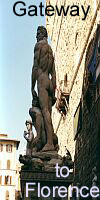
Florence Files
|
by La Signora Onorata
There is little extant and research in
this area, mostly being conjecture. There are two Florentine extant dresses:
Eleanora's burial dress - discussed in both La Moda a Firenze and Patterns of Fashion. Unfortunately
this gown does not have sleeves attatched. It is more recently been
conjectured that the sleeves may never have been present.
Red velvet dress from Pisa - discussed in La Moda a Firenze. This
dates from the 1560s and does have intact sleeves. This could give us
information on construction of the middle of the 16th century, when information is published.
Sumptuary Law and Sleeves:
A Florentine sumptuary law of 1439, limited trim and embroidery to
only be on the sleeves of an outfit. This caused a fashion of the
sleeves being the most decorated part of the outfit. This can be seen
in the early 1500's, such as Rafaello's Maddalena Doni (1506) and Bacchiacca's Lady with a Nosegay (1520's) Both can be seen below. Sleeves could also be fur-lined.
(Dressing Renaissance Florence).
From 1494, parts of an outfit were
often made separately (ie. sleeves and skirts). Renaissance
Clothing and Materials of Memory also confirms this (as also seen
in portraits). This also made it easier to replace worn out items. It
appears that there was a second-hand, a ready-made market, as well as
selling old linen for rags (this was used to make paper at the time.
There had been on occasion shortage of linen for making paper, making
it expensive... (but this is another story!)
Attatchments:
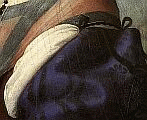
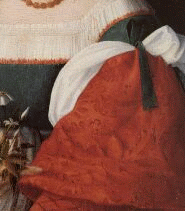
|
|
|
From my research, it appears that the sleeves (1510's)
were tied on, gradually changing to be laced in or sewn in,
in the later (mid 16thC). It is difficult to see, in some of the portraits, but the three examples below
show ties for the sleeves. Ties could be made out of the mathcing dress
material or in ribbons of contrasting colour.
Left is Rafaello's Maddalena Doni (1506)
Centre: Bacchiacca's Lady with a Nosegay (1520's)
Right: and later: Bronzino's Girl with a Book (1545),
tied with same material as the dress. |
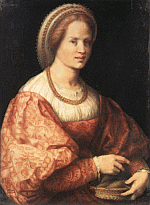 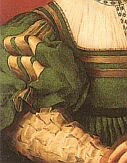
|
By the 1530s, the sleeve appears to be totally attatched to the
armhole. This may have been done either by sewing the sleeve in
completely, or by lacing the sleeve in. Lacing of sleeves was a common
method in Elizabethan dresses (as seen in Patterns of Fashion).
An early example of this can be seen in Pontormo's Lady with a basket of spindles 1516. Though this sleeve did not become common until the 1530s. (Far left)
Cartridge pleating can be
seen on Bronzino's Portrait of an Unknown Woman
(1530-32). (Left)
During the mid 1540's some sleeves were again tied to the armhole (as in Bronzino's Girl with a Book, above). In the 1550's, metallic and fancy buttons could be used to attatch the sleeves (
Bronzino:: Maria d'Cosimo,
1551 - below right). This continues into the 1560s. It appears that
sleeves of overgowns and zimarra/ loose gowns appear to be laced or sew
in.
|
|
Eleanor of Toledo's burial dress, 1562, (right) does
not have any eyelets or stitching to show lacings. Patterns of Fashion conjectured that the
sleeves were apparently destroyed by the time the dress was
available for study. If this was the case, this would suggest that sleeves, in
Eleanor's case, were not laced in.
Patterns of Fashion also surmises that buttons and loops
could have been the form of attatching the sleeves. (Flower)
buttons can be seen in the Portrait of Maria de Medici
(1551) - Right.
La Moda a Firenze suggests
that the sleeves were not made for this outfit. The gown (or petticoat
) could be worn without sleeves, when at home or in summer.
|
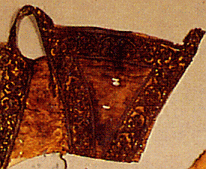
|

|
Style, Material, Decoration & Colours:
1510s & 1520s: The earlier teens and 20's have large 'bag' sleeves.
These appear to be often in contrasting colours, in damasks
and patterned materials, often tied onto the bodice.
1530s: We see the emergence of the 'two part' puffy
sleeve with baragoni (puffed upper sleeve) and tighter lower sleeve. This was first seen in the mid teens (1516 - Lady with basket of Spindles).
However, this does not seem to be seen again until the 1530s. The first
emergence of this sleeve (1516) shows it all in the same colour
and in the same colour as the dress. When we see it again, in the
portraits of the 1530s, the lower sleeve is more commonly of
contrasting colours or materials. The lower half is commonly slashed or
decorated and can be fur lined. The baragoni is often gathered in rows.
This high level of decoration, in contrast with the rest of the gown,
echoes the importance of sleeves
and the exemption in the sumptuary laws in the 1400s.
|
1540s: (Right: Maria de Medici, Girl with a
Book, 1545). The baragoni gets progressively smaller. Though Bronzino's early 1540's Portrait of Lucrezia Panciatichi shows
contrasting colours, this is early on. As the decade progresses, it
appears more common that the baragoni are usually the same color
and material of the dress itself, as in Bronzino's 1540's Portrait of
an Unknown Florentine Lady. he . Materials can be plain or patterned. There are examples of laced in , buttoned and tied on sleeves.\
1550's: The baragoni have almost disappeared. In their place are small 'puff's' or folds. These are usally same colour
as the lower sleeve and can be decorated with trim as in Bronzino's
Portrait of Maria de Medici (1551) - above. This type of sleeve is more practicle when wearing the fashionable zimmara (loose gown).
|
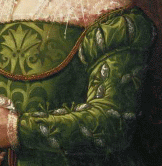
Unknown Florentine Noblewoman by Bronzino.
|
Sleeve Construction:
There is some conjecture as to whether the upper and lower
sleeves are sewn together, for this period, or remain in two parts.
Some portraits show a definite difference in materials, colours and
treatments for the lower part of the 'puffy topped sleeve'. This can
be found in the following:
|
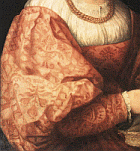
|

|
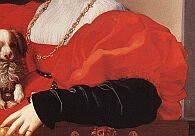
|
|
|
Appears to be all in one. Jacopo Pontormo's Lady with
a Basket of Spindles 1516,
|
Contrasting two part
An unknown lady attrib. to Angnolo Bronzino,
c.1530-32
|
Contrasting two part sleeve
Agnolo Bronzino Portrait of a Lady, 1533
|
|
There are a couple of ways this could be acheived.
Firstly the sleeve could be made in two parts, with the
lower half attatched to the upper half. Another is a petticoat (underdress)
worn underneath with straight sleeves (giving the lower half
of the sleeve) with the overdress having the upper, puffy
sleeves attatched. It is known that petticoats were worn under
gowns during this period.(La Moda a Firenze), providing part of the underskirts giving the voluminous look to Italian dresses.
Bronzino's 1540's Portrait of Lucrezia Panciatichi
(right) shows what looks like an undersleeve with
ribbons as stripes, through the slashes in the lower sleeve. This
could suggest a kirtle with striped/ribboned sleeves under
the slashed over sleeve. Looking carefully at Bronzino's Portrait of an Unknown Woman
(1530-32)
above the
|
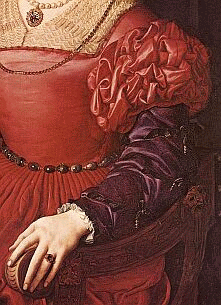
|
green upper sleeve appear to be a totally separate construct
to the lower sleeve. There is possibly even a hint that the lower
sleeve continues up further under the upper sleeve. Agnolo
Bronzino's Portrait of a Lady (above right in red and black) seems also to be separate pieces.
My theory is that the earlier sleeves may have been made
in one part or joined (Pontormo's lady with a Basket of
Spindles and Lotto's Lucrezia - both above).
Later sleeves (1530's & 40's) - above Bronzino's and the one (right - Portrait of Lucrezia Panciatichi 1540), look more like a separate top sleeve attatched to
the over dress, possibly with an undersleeve or laced in,
forming the lower half of the sleeve. This would have
been much cooler for Italian summers and could suggest either the lower
sleeve was attatched to the upper, or to a petticoate, but in any case,
removable.
La Mode a Firnenze states that the upper puffed sleeve (baragoni) was padded or stuffed.
Bibliography:
- Arnold, Janet Patterns of Fashion, MacMillan, London, 1985. ISBN: 0-333-38284-6
- Kovesi Killerby, Catherine, Sumptuary Laws in Italy 1200-1500, Oxford
University Press. NY. 2002. ISBN:0-19-924793-5
- Crowfoot E, Pritchard F & Staniland K, Textiles and Clothing
1150-1450, Boydell Press, Woodridge, 2001 (ed) ISBN: 0-85115-840-4
- Frick, Carole Collier. Dressing Renaissance Florence.: Families Fortunes
& Clothing. John Hopkins University Press. Baltimore. 2002. ISBN:
0-8018-6939-0
- Jones, Ann Rosalind & Stallybrass, Peter. Renaissance
Clothing and the Materials of Memory. Cambridge University
Press. 2003. ISBN: 0-521-78663-0
- Orsi Landini, Roberta & Niccoli, Bruna. La Moda a Fioenze 1540-1580.
Pagliai Polistampa, Firenze, 2005. ISBN: 88-8304-867-9
- Veccellio, Cesare. Vecellio's renaissance Costume Book. Dover
Publications. NY. 1977. ISBN: 0 48623441X
Web
Sites:
- Medici Archive Project: www.medici.org/ (1/06)
- Metopolitan Museum of New York. http://www.metmuseum.org/
- V&A Museum website: http://images.vam.ac.uk (May, 2004)
- Web Gallery: Medici portraits by Bronzino. http://www.kfki.hu/~/arthp/html/b/bronzino/1/index.html
- Festive Attyre: http://www.festiveattyre.com/research/secondflor/portfolio.html
- Eleanora of Toledo's dress extant can be found at
epee.goldsword.com/sfarmer/SCA/Paintings/
© K Carlisle. 2005- Oct, 2006
|
 |